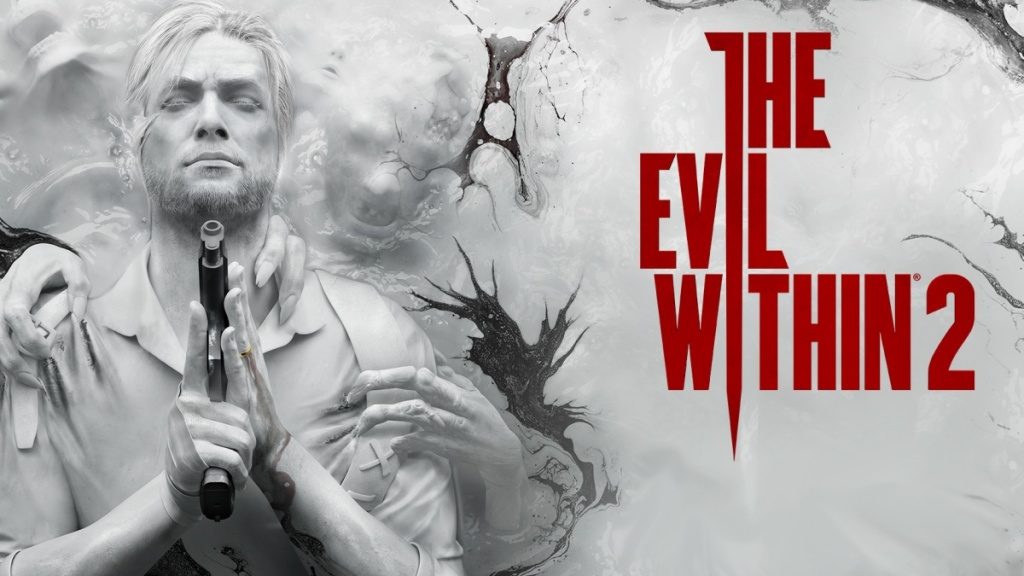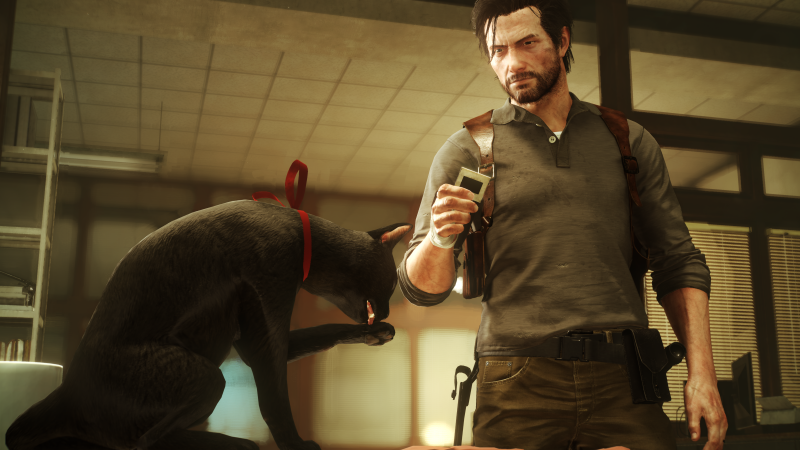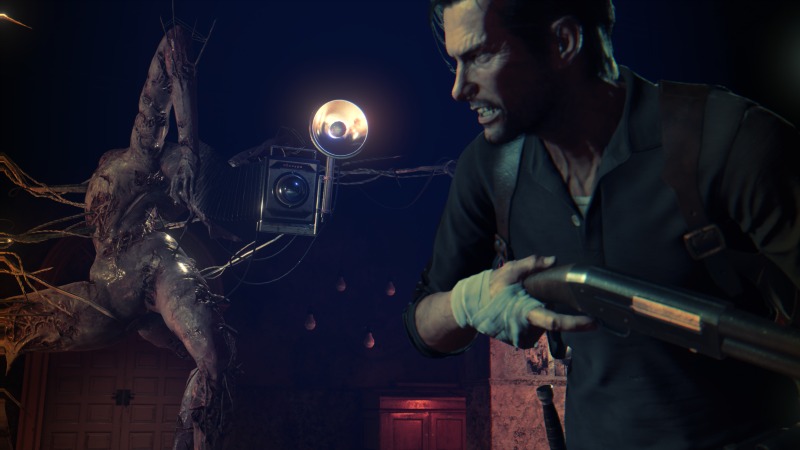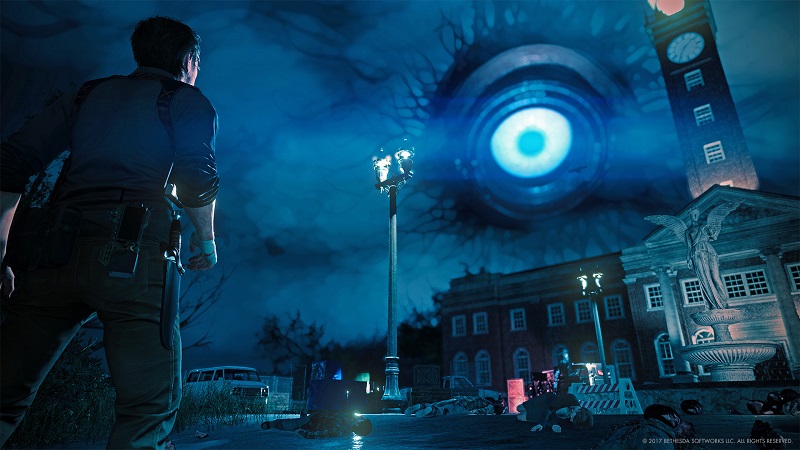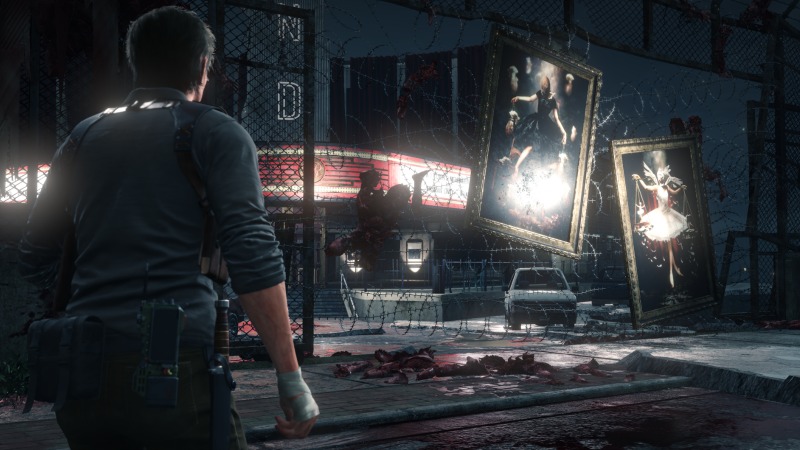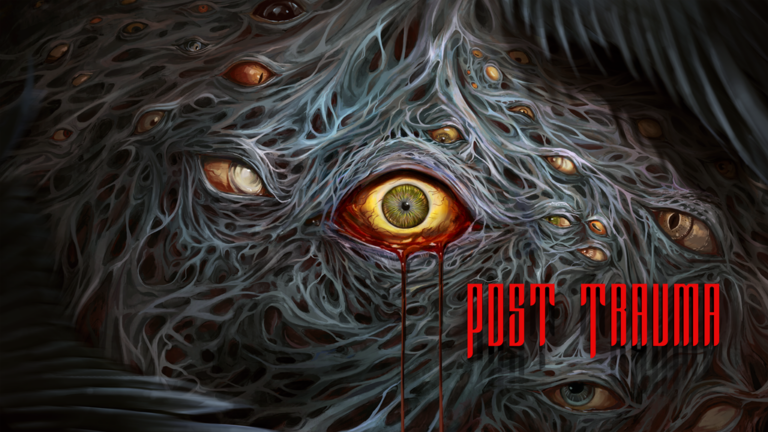2014’s The Evil Within was a divisive title among horror fans. A back-to-basics approach to survival horror from Shinji Mikami himself, it offered all the scares and tension of classic titles like Resident Evil, but was hamstrung by a slavish devotion to genre tropes and a nearly nonexistent narrative structure. Viewed by many as a spiritual successor to Resident Evil 4‘s style and gameplay, it never fully escaped the shadow of its zombified sister series, despite its psychological horror aspirations. The Evil Within 2, however, is an entirely different beast. By innovating on the gameplay established with the series’ initial outing and expanding the game’s scope and storytelling, The Evil Within 2 feels confident enough in its own skin to stand tall next to genre mainstays. It’s everything one could want from a sequel.
The game opens with our hero, the gruff detective-turned-alcoholic Sebastian Castellanos, drinking his days away, wracked with guilt over the death of his wife and daughter and traumatized by the events of the first game. Before long, Juli Kidman, his ex-partner and double agent for clandestine organization Mobius, informs him that not only is his daughter alive in a Mobius facility, but that she is inside a newly built version of STEM, the experimental nightmare machine from the first game. STEM connects the minds of those hooked up to it and creates worlds based on their subconscious. With Sebastian being one of the few survivors of the incident at Beacon Mental Hospital, he is uniquely qualified to enter STEM and find out what has happened to a missing Mobius search team. Taking the opportunity to save his daughter, Sebastian enters STEM and makes his way through the artificially constructed city of Union, where he finds a madman has taken control and monsters roam the streets.
While the opening scenes do a much better job of setting the story’s tone and character motivations than the first title’s immediate dive into madness, the dialogue and voice acting here gets pretty cheesy in a way that doesn’t do the rest of the game justice; it’s not a good first impression, but it gets better as the game goes on. It is also a lot of information for players to process, and if you’re not paying attention it can get pretty convoluted fast. Thankfully, the sci-fi conceits of the story are eventually expanded upon in a way that makes good on the high-concept potential of the story, which is another improvement over STEM’s poor explanation in the first title.
I knew The Evil Within 2 would have a greater emphasis on storytelling, but I was initially unsure of the quality. The opening moments are cheesy and don’t give characters any time to breathe, choking the life from each scene as it drags them from plot point to plot point. But as Sebastian makes his way through STEM, I was pleasantly surprised how much I came to know him as a character.
Gone is the bland cypher of the first game who reacted to everything with almost nothing to actually say. Sebastian Castellanos of The Evil Within 2 is an angry, broken person, but not one without a heart. He makes jokes, he forgives, and he is drawn to helping people who deserve it. His singular quest to find his daughter is instantly reminiscent of Silent Hill and The Last of Us, but focuses less about the things he’s willing to do for her as much as why he’s willing to do them; The Evil Within 2 is a story of redemption for a man who needs to learn to forgive himself.
Sebastian’s arc is the core of The Evil Within 2‘s story, but the game offers a lot of narrative meat to chew outside of his struggles. Files scattered around the environment flesh out the shadowy Mobius organization, and projector slides found throughout the game give way to tender conversations between Sebastian and Kidman. Other characters and villains duck and weave throughout the game’s story, and while I wish some lingered longer than others, they all manage to be memorable in their own ways thanks to brief moments of quality characterization. Fantastic cutscene direction and a number of strong twists created several moments I genuinely didn’t expect; some caused my jaw to drop, and others actually had me a little emotional. The game certainly maintains a level of cheese throughout, but The Evil Within 2 still manages to pull at a few heartstrings when it really counts.
As with the story, nearly every aspect of The Evil Within 2’s gameplay has been overhauled, built from the ground up for a new and interesting experience. Players can still choose to go in guns blazing or stealthily, but the progression system has been reworked to offer more choice, as well as reward exploration. Gunplay is relatively the same, but everything feels tighter and more satisfying, from the sway of a gun to the satisfying sounds they make when they fire. Stealth is much easier to grasp, thanks to a slick cover system, and stealth kills are always satisfyingly vicious; gone is the singular, canned kill animation from 2014.
Guns can be upgraded with weapon parts found throughout the environments, while Green Gel makes a return to upgrade Sebastian’s abilities. There is an impressive variety of skills to upgrade, and though I got around to upgrading most of the ability tree during my 15-hour playthrough, I always felt like I was making genuine progress. Rare items like high-grade weapon parts and Red Gel are hidden throughout the environment and open up new upgrades for players to unlock. These items create a rewarding loop of exploration and upgrading which had me scouring every place I could for hours on end.
Speaking of exploration, The Evil Within 2‘s biggest surprises lie in its open-world hubs. In between more linear sections and boss fights, Sebastian is free to explore Union, using a transponder device to find signals which can lead to sidequests, upgrades, or just small glimpses of stories that have occurred in the town. Union is beautifully detailed and feels like a place which could be genuinely habitable without the twisted monstrosities roaming the streets. But The Evil Within 2 isn’t just jumping on an open-world bandwagon in an effort to pad out the game’s length; these sections are just another tool in its arsenal, lending the game a fantastic sense of pacing that kept me engaged for hours on end. If I had one major complaint about the game, it’s that there weren’t more sections of just exploring Union.
The Evil Within 2 manages to pull off a few clever tricks to make an open world fun to explore, yet still filled with tension. Union is a place of constant risk and reward. See an ammo upgrade over there? It’s guarded by an acid-spitting creature that can kill you in one hit. Found a signal for an interesting sidequest? Be careful not to alert the horde of creatures wandering nearby. One time I had just escaped a group of enemies then ducked behind a car to replenish my stamina. Suddenly a dead body in the front seat jumped out of the windshield and gave pursuit; I haven’t had such a good jump scare since middle school. There is a fantastic sense of randomness woven into Union’s design that pushes players to come up with creative solutions to its tense situations. Even with full health and a good stock of ammo, I never felt safe wandering the streets to my next objective.
The same strong sense of pacing extends to the entirety of The Evil Within 2. Boredom was a stranger to me as I was always just one wrong move away from being helpless. The first game struck a good balance between shooting, stealth, and bosses, but the sequel goes much farther, including an entirely first-person stealth section and another scenario I can only imagine as an homage to Arkham Asylum‘s Scarecrow nightmares. Like Hellblade, another 2017 title with fantastic pacing, The Evil Within 2 is confident enough in its own gameplay to always try something new, pushing the player to think outside the box as they progress through the game, and the result is a stronger, more varied experience than its predecessor.
Even enemy design gets flipped on its head in a number of interesting ways. The standard zombie-like enemies wandering Union are fairly easy to dispatch on their own, but they will try to swarm Sebastian en masse when alerted, forcing a retreat. They also don’t fall for the same tricks as they did in The Evil Within. No longer will a single shot to the knee make them fall down; the knee has to be shot off entirely, Dead Space-style. Some enemies also catch fire periodically and will be able to push Sebastian away if he tries to stealth kill them while immolated. Combined with the open-world randomness of Union, there are persistent and unexpected threats to keep players on their toes. I do have some minor gripes about boss variety, however. Most of the game’s bosses are visually interesting and challenging, but almost all of them can be dispatched with just regular gunfire. It’s a bit of a bland choice for an otherwise varied experience.
One of the strongest points of The Evil Within was its art design, and 2 continues the tradition. Inside the fractured world of STEM, realities shift constantly, lending a wonderful surrealism to Sebastian’s quest. Some of the enemy designs can feel a bit messy or generic at times, but the bosses are absolutely fantastic, (I really wouldn’t mind an Obscura statue on my desk just to stare at sometimes.) The artistic main antagonist, Stefano, also brings a certain darkly extravagant flair with him, adorning his territories with pieces of twisted paintings and photographs that turn the game into one big homicidal art show. Like the combat and story, The Evil Within 2‘s visual stylings never rest on their laurels; there’s something new and interesting waiting around the corner.
The visuals and overall presentation of The Evil Within 2 also shine, thanks in part to the game’s new STEM Engine. Based on idTech 6, the new engine provides often breathtaking visual fidelity to the game’s environments, particularly the textures and lighting effects. Light sources shine realistically off of even the smallest details, like the buckles on Sebastian’s holster, and textures are impeccably detailed, breathing life into STEM’s world in a way that the constant gray hues of the first game never could. Character models look good throughout, and animate well, but the real visual treats are in the environments.
But further than just the graphics, the overall presentation of The Evil Within 2 is on another level from its predecessor. Gameplay regularly transfers directly to and from cutscenes, and loading times are rarely more than a few seconds, even in between larger areas. Loading from death can take a bit longer, but never enough to hamper the experience. I really don’t want to spoil anything, but there is a particular late-game section that honestly blew me away with its perspective work; it’s one of my favorite gaming moments this year.
From the revving of a chainsaw to wet splashes of gore and viscera, The Evil Within had sound design nailed, and its sequel certainly doesn’t disappoint. While gunfire has been noticeably improved and the game has a slightly more memorable score, there’s honestly only so much a horror game can do with its sound design, and The Evil Within 2 checks the necessary boxes. Bones snap and bodies break with sickening resonance, and enemies groan and chatter menacingly as they hunt Sebastian down. Like I mentioned earlier, some of the voice performances can get a little rocky, but once the game gets going, I never found them to be distracting.
The Evil Within 2 is everything I wanted from a sequel to The Evil Within, and it surprised me at every turn. Strong pacing, rewarding progression, and innovative level design set a solid foundation for the franchise’s future, and underneath a few layers of cheese and grit is a story worth experiencing for its creativity and strong emotional core. If The Evil Within was a modern take on classic survival horror, then The Evil Within 2 is the next step for the genre. It’s everything a sequel should be and has earned the series a place next to names like Silent Hill and Resident Evil.
Now excuse me while I go play through it one more time.
 (9.5 / 10)
(9.5 / 10)
Amazing
 (9.5 / 10)
(9.5 / 10)
